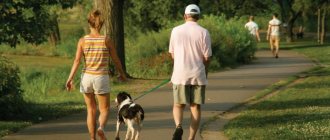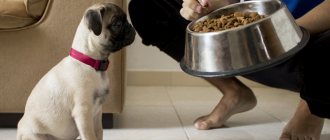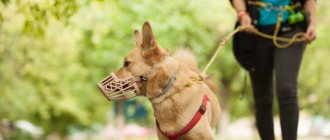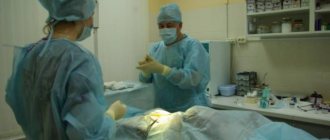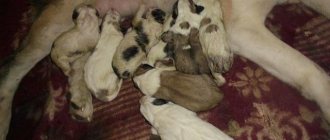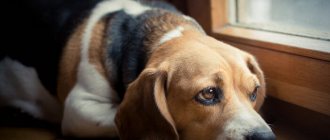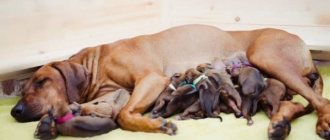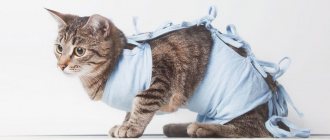How dogs digest food
Animal digestion is different from human digestion. For the full functioning of the body, a special diet is selected. It is important to take into account some features of the pet:
- age;
- weight;
- breed;
- activity.
Initially, food is crushed by teeth, mixed with saliva and swallowed. Sometimes dogs swallow food whole. It easily passes through the esophagus thanks to saliva containing mucus and enters the stomach. In this organ, food is mixed with enzymes and begins to break down, and everything continues in the intestines. Dogs are not able to digest coarse fiber, because their intestines are two times shorter than those of humans, and the body does not have enough time for this.
During digestion in dogs, the following processes occur:
- breakdown of proteins into amino acids;
- breakdown of fats into fatty acids and glycerol;
- transformation of carbohydrates into glucose.
Expert opinion
Anna Abramenko
An avid dog lover. Experience in veterinary medicine since 2009.
Ask a Question
The body absorbs all elements that serve as a source of energy. If there are fewer necessary substances, the dog will weaken, if more, its health will deteriorate. To prevent problems with digestion and other organs, you need to choose a balanced and proper diet for your pet.
When to feed your dog: before or after a walk
A dog is not only man's best friend, but also a constant daily responsibility. It’s not for nothing that they say: “We are responsible for those we have tamed.”
A puppy that appears in the house requires attention and care from the first days, as well as strict education and strict adherence to the regime. In this regard, many owners who have a four-legged friend for the first time have a question: When to feed the dog, before or after walking?
The answer in this case is quite simple. The physiology of a dog is not much different from that of a human; after a hearty meal, he will not want to actively explore the world, so it is best to feed your pet after returning from the street.
Regardless of the breed or activity during the day, physical activity and character, any dog obeys its physiology, which means it will want to eat after it has actively run and relieved itself of all its needs.
What happens during a walk
Dogs need to be walked several times daily. This is necessary to improve your general condition:
- stimulation of metabolic processes, nervous system, heart function;
- increased blood circulation;
- prevention of obesity, constipation, joint pathologies;
- socialization of the animal;
- maintaining the psycho-emotional state of the dog;
- to cope with natural needs.
The duration of the walk depends on the breed, age of the pet and weather conditions. If this is a decorative elderly dog, 2 hours a day is enough. Hunting, fighting, and young dogs need long walks - 4 hours or more. During them, additional stress is required: rhythmic games and exercises.
Old individuals are not able to run for long; activity is a burden for them. This is associated with joint diseases and abnormalities in the functioning of other organs. You should not force your dog to overwork, this will have a bad effect on his health.
In extreme heat or cold, it is not advisable to walk the dog for a long time; walking time is kept to a minimum. If you have special clothing that will protect your animal from wind and cold, you won’t have to worry about hypothermia in winter. In rain and slush, limit yourself to a few minutes - they will be enough to fulfill your needs.
If you teach a dog from an early age to go to the toilet during a walk, this will develop a certain routine for the pet and make life easier for the owner. An animal can tolerate up to 10 hours, but this is harmful to the body. When the bladder is full for a long time, the risk of cystitis increases. Retention of feces also does not go away without a trace: there may be constipation or inflammation of the colon. To prevent such consequences, it is advisable, in addition to the two main walks, to take the dog out 2-3 times for a few minutes. It is especially recommended to walk with your dog before bed for proper rest.
Remember! During the day, your pet can empty its bowels twice and urinate 4-6 times.
How is a dog supposed to go to the toilet?
A pet can have bowel movements up to 2 times a day. He relieves himself approximately 6 times a day. It is recommended from an early age to teach your dog to defecate only during a walk. It is worth remembering that with a full bladder, the risk of kidney inflammation and cystitis increases. If stool is retained, constipation or inflammation of the colon may occur. So that your pet does not have to endure it, it is necessary to walk it several times a day, and also sometimes take it outside for a short time and take a walk in the evening before going to bed.
Many people don’t understand how a dog will go to the toilet if it hasn’t eaten before the walk. The fact is that the dog cannot defecate immediately after feeding, since it takes a certain amount of time to break down the food. The pet will be able to go to the toilet, even if it did not eat before walking. The owner’s task is to teach his pet to defecate during walks.
Animal on a walk
Walking rules
It is advisable to walk your dog in the morning and evening. The first exit will be short: half an hour or an hour. The second one is long-lasting; all the accumulated energy will be spent on it. Here the owner can train the pet, cultivate discipline and obedience. Following commands, the dog will not have enough time for pranks and hooliganism, he will get tired and go home happy.
During the walk, the pet must have time to:
- go to the toilet;
- to be with others like you;
- run;
- communicate with the owner and carry out a number of his commands.
Only if all points are completed can the walk be considered successful.
Keep in mind! On the street, the dog gets to know the world around him, establishes contact with the owner, receives positive emotions, and releases excess energy.
If the owner decides to take his pet for a walk, then a number of rules must be followed:
- Don't leave the animal alone. This can end badly for both the dog and those around him. It is possible that you will go out onto the roadway or into a pack of wild dogs. Also, your pet may eat something poisonous or spoiled, resulting in poisoning. Often, untrained dogs rush at passers-by, and this is already punishable by law.
- Find a good place to walk. Avoid areas where there are garbage dumps, roads, schools, and kindergartens. In the absence of special sites, a park or square is preferable.
- Do not allow your animal to eat anything outside. Food may be poisoned or contain pathogens that will lead to various diseases.
- If the dog feels unwell, do not burden it with active training, give it the opportunity to just take a walk and relieve itself.
- When going out into a crowded place, put a muzzle on the dog and keep it on a leash.
- Do not allow your pet to interact with sick and ill-mannered dogs. He will take on all the bad qualities and may become infected with some kind of illness.
Remember that walking should not be a burden for your pet. If he enjoys it, then he will feel good.
How to build a walking regimen most effectively?
The schedule of walks and their duration depend on a number of important factors, the main one of which is the owner’s availability of free time. Most modern owners structure their daily routine so that they can walk with their four-legged friend in the morning before work/school and in the evening. If you have more free time, you can increase the duration and frequency of walks.
Features of walking depend on:
- The age of the animal. The puppy should be outside as often as possible to get used to relieving itself outside the house. It is then that he remembers where to go to the toilet and gets used to asking. However, at first you can leave the house for a short period of time from 15 to 30 minutes. Starting from 6 months, you can gradually reduce the number of exits and reduce them to 2, but at the same time increasing the duration. The same process occurs in parallel with nutrition. The puppy, who previously ate up to 6 times a day, is gradually transferred to twice a day feeding. If you do everything synchronously, then the dog’s internal rhythms will coincide, and he will get used to enduring until the required time.
- Health and training. Animals on a special regime completely change their daily routine. For example, during a period of quarantine after illness or surgery, the dog is either not taken outside at all or released for a very short period of time. And if the animal undergoes canine training or is actively involved in sports, then much more time is spent outside the home. Depending on this, nutrition may change. A sick animal often feeds much more often, but in small portions, but dogs leading a hyperactive lifestyle can be transferred to one-time feeding.
- The time of year also makes its own adjustments. If in the warm months, when the sun is very active, veterinarians and breeders advise walking early in the morning and late in the evening so that the dog does not overheat and lose its color, if it has dark fur, then with the onset of winter and cold weather it is better to move it a little so that walking coincided with the warmer part of the day and took less time.
Build a feeding and walking schedule based on your own daily routine and never break it, because by giving in to your mood, you throw off your pet’s internal clock and deprive him of confidence in the future. This can lead to unpleasant consequences both physically and psychologically.
There are certain rules that should be followed if there is a dog in the house. The pet needs to be walked regularly and provided with a proper and nutritious diet. Dog breeders recommend adhering to a diet and never giving forbidden foods, as they significantly undermine the pet’s health and shorten its life. It is important to know when to feed your dog: before or after a walk.
What can and cannot be given
Dogs can eat different foods, but this does not mean that you can give your pet anything. It is important to feed your dog properly. There are foods and substances that harm the animal’s body:
- Currants and grapes. Kidneys are affected.
- Mushrooms. Contain toxins that lead to poisoning and death.
- Fats. They become the cause of pancreatitis.
- Potato. It often causes diarrhea.
- Bones of fish, birds and animals. Causes intestinal obstruction and organ ruptures.
- Sweets. Teeth become damaged and body weight increases.
- Citrus. They provoke vomiting.
- Onion garlic. Anemia occurs.
- Raw meat. It may contain E. coli or salmonella.
- Chocolates. Affect the functioning of the heart and central nervous system. Vomiting and diarrhea also appear.
- A raw egg. Leads to salmonellosis, problems with the skin and coat.
- Bouillon. Poorly absorbed, diarrhea occurs.
- Lots of salt. Possible electrolyte imbalance.
- Oatmeal, egg. They are not processed by the body and can cause allergies.
- Peas. It is poorly digested, causing bloating, flatulence, pain and intestinal upset.
- Yeast dough. It ferments and causes gas formation and pain in the digestive system.
You are allowed to give your dog:
- Meat of rabbit, chicken, turkey, ram, cow, horse scalded with boiling water.
- Boiled spleen, liver, lungs or stomachs.
- Boiled cereals (buckwheat, rice, semolina).
- Fermented milk products (cottage cheese, yogurt, sour cream, kefir, fermented baked milk).
- Fruits in small quantities (banana, apple, apricot, watermelon, melon, kiwi, plum).
- Vegetables (pumpkin, grated carrots, cabbage, cucumber).
Keep in mind! You need to add 10–15 ml of vegetable oil to your dog’s food. It is not forbidden to introduce greens (parsley, leeks, dill).
You can periodically give dry food; it contains all the necessary elements for the normal functioning of organs. It is better to feed your dog good ingredients; cheap ones do not contain the necessary vitamins, micro- and macroelements.
When to walk your dog: before or after meals?
When to feed a dog: before or after a walk, knowledge about the physiological processes in its body suggests. If you give food before going out into the fresh air, the dog will not be able to be active. Its energy will mainly be spent on assimilation and digestion of products that have entered the digestive organs. Because of this, it is difficult to attract the dog to games, to force it to comply with commands and requirements.
As a result, the dog quickly gets tired and spends too much energy, and the load on the cardiovascular system also increases. Over time, health problems and refusal to go outside may begin.
Food digestion process
The process of assimilation of food is individual for each dog. When swallowed, food is moistened with saliva, after which it passes through the esophagus straight into the stomach. In the stomach, proteins and fats are broken down into amino acids, fatty acids and glycerol. Carbohydrates are transformed into glucose.
When food is digested, the body absorbs all the necessary substances that serve as a source of energy. The diet should be balanced, since if there is a lack of nutrients, the pet’s body will weaken, and if there is an excess, the health will deteriorate.
Important! The diet should be based on the character of the pet, its age, body weight and breed.
To understand whether to walk your dog after a meal or before a meal, you need to take into account the blood circulation process. The circulatory system supplies oxygen and nutrients to absolutely all organs, including the stomach and intestines.
Once food enters the stomach and the digestion process begins, blood circulation increases and the heart is put under strain. The body spends energy to break down proteins, fats and carbohydrates into useful substances.
If you feed your dog before walking, it will be extremely inactive, all its energy will be spent on digesting food. It will be difficult to motivate your pet to carry out actions and commands. It is especially not recommended to feed your dog before active training. Not only will he get tired quickly, but he also risks developing health problems.
Meat is the main food ingredient for dogs
Important! When digesting food, the body expends energy. There is a load on the heart and increased blood flow. Therefore, feeding the dog should occur a couple of hours before or after the prescribed walk. Otherwise, the body will be overloaded.

